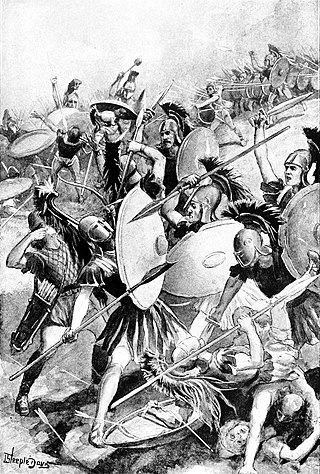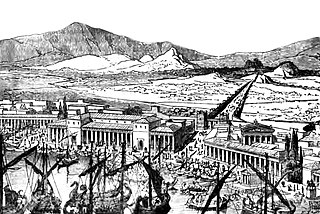Related Research Articles

The Second Peloponnesian War, often called simply the Peloponnesian War, was an ancient Greek war fought between Athens and Sparta and their respective allies for the hegemony of the Greek world. The war remained undecided until the later intervention of the Persian Empire in support of Sparta. Led by Lysander, the Spartan fleet finally defeated Athens which began a period of Spartan hegemony over Greece.

Pericles was a Greek politician and general during the Golden Age of Athens. He was prominent and influential in Ancient Athenian politics, particularly between the Greco-Persian Wars and the Peloponnesian War, and was acclaimed by Thucydides, a contemporary historian, as "the first citizen of Athens". Pericles turned the Delian League into an Athenian empire and led his countrymen during the first two years of the Peloponnesian War. The period during which he led Athens as Archon (ruler), roughly from 461 to 429 BC, is sometimes known as the "Age of Pericles", but the period thus denoted can include times as early as the Persian Wars or as late as the following century.
This article concerns the period 439 BC – 430 BC.

The Sicilian Expedition was an Athenian military expedition to Sicily, which took place from 415–413 BC during the Peloponnesian War between Athens on one side and Sparta, Syracuse and Corinth on the other. The expedition ended in a devastating defeat for the Athenian forces, severely affecting Athens.

The Battle of Naupactus was a naval battle in the Peloponnesian War. The battle, which took place a week after the Athenian victory at Rhium, set an Athenian fleet of twenty ships, commanded by Phormio, against a Peloponnesian fleet of seventy-seven ships, commanded by Cnemus.
The Battle of Sybota took place in 433 BC between Corcyra and Corinth. It was one of the immediate catalysts for the Peloponnesian War.

The Battle of Potidaea was fought in 432 BC between Athens and a combined army from Corinth and Potidaea, along with their various allies. Along with the Battle of Sybota, it was one of the catalysts for the Peloponnesian War.
Phormio, the son of Asopius, was an Athenian general and admiral before and during the Peloponnesian War. A talented naval commander, Phormio commanded at several famous Athenian victories in 428 BC, and was honoured after his death with a statue on the acropolis and a state funeral. He is considered one of Athens' many great admirals, alongside Themistocles and Cimon.
Lacedaemonius was an Athenian general of the Philaid clan. He served Athens, notably in the naval Battle of Sybota against the Corinthians in 433 BC.
The Megarian Decree was a set of economic sanctions levied upon Megara c. 432 BC by the Athenian Empire shortly before the outbreak of the Peloponnesian War. This move is considered one of the first uses of economics as a foreign policy tool. The decree addressed the Megarians' supposed trespass on land sacred to Demeter known as the Hiera Orgas, the killing of the Athenian herald who was sent to their city to reproach them, and giving shelter to slaves who had fled from Athens. The Megarian decree effectively blocked Megara from trading in any port within the Delian League, isolating the city and greatly damaging its economy. The exact influence the Megarian Decree had on the beginning of the Peloponnesian War is a matter that is highly debated to this day.
The Battle of Megara was fought in 424 BC between Athens and Megara, an ally of Sparta. Whilst the Athenian forces were initially successful against the Peloponnesian garrison there, a hasty arrival of Spartan forces under Brasidas saw a stalemate and eventual victory of the oligarchic party within the city of Megara and the withdrawal of Athenian forces.

Although long walls were built at several locations in ancient Greece, notably Corinth and Megara, the term Long Walls generally refers to the walls that connected Athens' main city to its ports at Piraeus and Phaleron.

Pentecontaetia is the term used to refer to the period in Ancient Greek history between the defeat of the second Persian invasion of Greece at Plataea in 479 BC and the beginning of the Peloponnesian War in 431 BC. The term originated with a scholiast commenting on Thucydides, who used it in their description of the period. The Pentecontaetia was marked by the rise of Athens as the dominant state in the Greek world and by the rise of Athenian democracy, a period also known as Golden Age of Athens. Since Thucydides focused his account on these developments, the term is generally used when discussing developments in and involving Athens.

The Samian War was an Ancient Greek military conflict between Athens and Samos. The war was initiated by Athens's intervention in a dispute between Samos and Miletus. When the Samians refused to break off their attacks on Miletus as ordered, the Athenians easily drove out the oligarchic government of Samos and installed a garrison in the city, but the oligarchs soon returned, with Persian support.
The First Peloponnesian War was fought between Sparta as the leaders of the Peloponnesian League and Sparta's other allies, most notably Thebes, and the Delian League led by Athens with support from Argos. This war consisted of a series of conflicts and minor wars, such as the Second Sacred War. There were several causes for the war including the building of the Athenian long walls, Megara's defection and the envy and concern felt by Sparta at the growth of the Athenian Empire.
The Mytilenean revolt was an incident in the Peloponnesian War in which the city of Mytilene attempted to unify the island of Lesbos under its control and revolt from the Athenian Empire. In 428 BC, the Mytilenean government planned a rebellion in concert with Sparta, Boeotia, and certain other cities on the island, and began preparing to revolt by fortifying the city and laying in supplies for a prolonged war. These preparations were interrupted by the Athenian fleet, which had been notified of the plot, and the Mytileneans sent representatives to Athens to discuss a settlement, but simultaneously dispatched a secret embassy to Sparta to request support.

Classical Greece was a period of around 200 years in Ancient Greece, marked by much of the eastern Aegean and northern regions of Greek culture gaining increased autonomy from the Persian Empire; the peak flourishing of democratic Athens; the First and Second Peloponnesian Wars; the Spartan and then Theban hegemonies; and the expansion of Macedonia under Philip II. Much of the early defining mathematics, science, artistic thought, theatre, literature, philosophy, and politics of Western civilization derives from this period of Greek history, which had a powerful influence on the later Roman Empire. Part of the broader era of classical antiquity, the classical Greek era ended after Philip II's unification of most of the Greek world against the common enemy of the Persian Empire, which was conquered within 13 years during the wars of Alexander the Great, Philip's son.
The period of the 5th century BC in classical Greece is generally considered as beginning in 500 BC and ending in 404 BC, though this is debated. This century is essentially studied from the Athenian viewpoint, since Athens has left more narratives, plays and other written works than the other Greek states. If one looks at Athens, our principal source, one might consider that this century begins in 510 BC, with the fall of the Athenian tyrant and Cleisthenes's reforms. If one looks at the whole Greek world, however, we might place its beginning at the Ionian Revolt in 500 BC, that provoked the first Persian invasion of 492 BC. The Persians were finally defeated in 490 BC. A second Persian attempt failed in 480–479 BC. The Delian League then formed, under Athenian hegemony and as Athens' instrument. Athens' excesses caused several revolts among the allied cities, which were all put down by force, but Athenian dynamism finally awoke Sparta and brought about the Peloponnesian War in 431 BC. After both sides were exhausted, a brief peace occurred, and then the war resumed to Sparta's advantage. Athens was definitively defeated in 404 BC, and some internal Athenian agitations ended the 5th century in Greece.
The Thirty Years' Peace was a treaty signed between the ancient Greek city-states of Athens and Sparta in 446/445 BC. The treaty brought an end to the conflict commonly known as the First Peloponnesian War, which had been raging since c. 460 BC.
Aristeus, son of Adeimantus, was a Corinthian general who commanded the expedition to Potidaea in 432 BC. After the Athenians broke a truce with the Corinthians at Sybota, his primary goal was to defend Potidaea from an Athenian attack. He then went on to defend the Corinthian colony from Athens during the Battle of Potidaea in 432 BC, until he was left with no option but to leave the colony with the Chalcidians. In 430 BC he traveled to Thrace with Spartan envoys where they were discovered by Athenians and brought to Athens, by Athenian ambassadors, where they were promptly killed without a trial. After Aristeus' death, Athens seized Potidaea in 430/429 BC during the Peloponnesian War, the battles of Sybota and Potidaea being two main catalysts for the war.
References
- ↑ Thucydides, 1.26, 1.46.
- ↑ Thucydides, 1.
- ↑ Rhodes 2010, p. 88.
- ↑ Thucydides, 1.24.
- ↑ Thucydides, 1.25.
- 1 2 Thucydides, 1.26.
- ↑ Kagan 2005, p. 27.
- ↑ Kagan 2005, p. 28.
- 1 2 Kagan 2005, p. 29.
- ↑ Thucydides, 1.28–9.
- ↑ Kraay 1979.
- 1 2 Legon 1973.
- ↑ Kagan 2005, p. 33.
- ↑ Thucydides, 1.31.
- ↑ Kagan 2005, p. 30.
- ↑ Thucydides, 1.36.
- ↑ Kagan 2005, p. 31.
- ↑ Kagan 2005, p. 32.
- ↑ Plutarch & Clough 1942, p. 356.
- ↑ Thucydides, 1.45.
- ↑ Kagan 2005, pp. 33–34.
- ↑ Thucydides, 1.46.
- ↑ Thucydides, 1.47.
- ↑ Thucydides, 1.49.
- ↑ Kagan 2005, p. 34.
- ↑ Thucydides, 1.56.
- ↑ Lang 1968, p. 173.
- ↑ Kagan 2013.
- ↑ Hubbell 1929.
- ↑ Kagan 2005, p. 39.
- ↑ Franko 2009.
Sources
- Franko, George Fredric (2009). "Epidamnus, Thucydides, and "The Comedy of Errors"". International Journal of the Classical Tradition. 16 (2): 234–240. doi:10.1007/s12138-009-0121-7. ISSN 1073-0508. JSTOR 40388895. S2CID 195318709.
- Hubbell, Harry M. (1929). "The Chronology of the Years 435-431 B. C." Classical Philology. 24 (3): 217–230. doi:10.1086/361133. ISSN 0009-837X. JSTOR 262844. S2CID 161870361.
- Kagan, Donald (2005). The Peloponnesian War: Athens and Sparta in savage conflict, 431-404 BC. London. ISBN 0-00-711506-7. OCLC 60370044.
{{cite book}}: CS1 maint: location missing publisher (link) - Kagan, Jonathan (2013). "Epidamnus, Anactorium, and Potidaea: Corinthian-style Pegasi at the Outbreak of the Peloponnesian War". American Journal of Numismatics. 25: 1–9. ISSN 1053-8356. JSTOR 43580622.
- Kraay, Colin Mackennal (1979). The Coinage of Ambracia and the Preliminaries of the Peloponnesian War.
- Lang, Mabel L. (1968). "Thucydides and the Epidamnian Affair". The Classical World. 61 (5): 173–176. doi:10.2307/4346440. JSTOR 4346440.
- Legon, Ronald P. (1973). "The Megarian Decree and the Balance of Greek Naval Power". Classical Philology. 68 (3): 161–171. doi:10.1086/365974. ISSN 0009-837X. S2CID 159686637.
- Plutarch; Clough, Arthur Hugh (1942). Plutarch's Lives. Translated by Dryden, John. Modern Library.
- Rhodes, Peter John (2010). A History of the Classical Greek World 478–323 BC (2 ed.). Chichester: Wiley-Blackwell.
- Thucydides. History of the Peloponnesian War. Translated by Crawley, Richard.